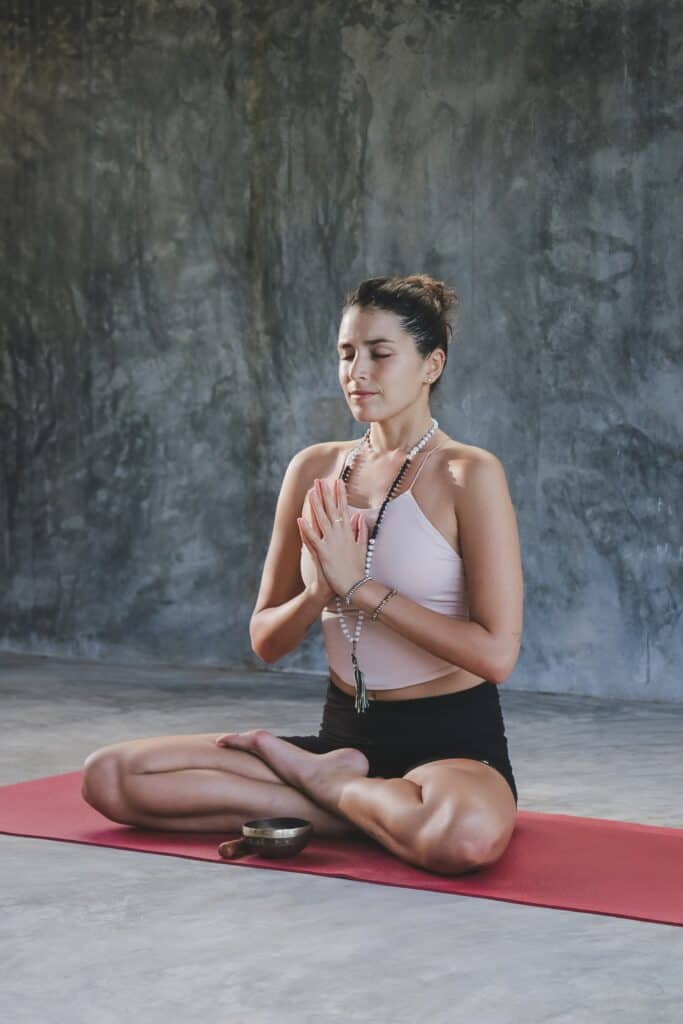Contents
This article will specifically focus on how to do mindfulness meditation. There are an endless number of benefits which are backed by research on mindfulness meditation in 4 simple steps. I also wrote an article highlighting three things that stood out to me as beneficial by practicing mindfulness meditation. The type of mindfulness meditation that I’ll be teaching in this article is Samatha Vipassana mindfulness meditation.
I’ll give a brief introduction on what mindfulness meditation is. This is when your attention is simply focused on the things that are happening in the present moment without judgement. It is awareness, completely objective, and centered on the current moment.
What is Samatha and Vipassana?
We will be learning Samatha Vipassana mindfulness meditation, so I will explain what these things mean as well.
Samatha means tranquility. Vipassana means insight. Therefore, this type of meditation will allow us to get in a calm state in which we will begin to understand the nature of what’s happening within our consciousness. Buddha himself practiced meditation to get the effects of Samatha and Vipassana.
Steps To Begin Mindfulness Meditation
Here are the steps on how to do mindfulness meditation.
Step 1: Find a Spot

The first step is to find spot which is quiet and away from distraction. This place can be inside your house such as your room. Although, don’t do it on your bed. It can also be outside. Ideally, as long as it’s away from distractions, loud noises, or discomfort, it will suffice.
Step 2: Setup

The second step is setting up your area. Ideally, you want to avoid sitting on a chair or anything that will support your back. One of the main reasons for this is that it will lead to sleepiness in some cases. Your back muscles will gradually become stronger and keep you erect without struggle as you sustain this practice.
Step 3: Posture and Position

You will want to sit cross legged and find a cushion to sit on. If you don’t have a cushion, a pillow might do. The cushion will allow your behind to be raised so your knees are level with your hips, otherwise the posture will be highly uncomfortable and keeping a straight and erect back will be very hard.
Just remember to be patient. With time, your posture will become comfortable, but you will need to give your muscles time to adjust to this new strain that it isn’t used to. A note, if you have a medical condition which hinders you from sitting erect without any object, then feel free to sit in any position that adheres to your condition.
Step 4: The Practice

The fourth step is to begin your practice. First remind yourself that you will be doing Samatha Vipassana mindfulness meditation.
The Breath
Begin to transition your focus on the sensations that come from your in breath and out breath. You will notice that your back movies, you feel sensations in or around your nose, your stomach rises and falls, and so on.
We will primarily focus on the stomach. When your inhale, you will observe your stomach rises or expands. When you exhale, your stomach falls.
Be mindfulness of the sensations of your stomach as it rises, quietly. Do the same for your stomach begins to fall. Do not try to force yourself to breathe in or out very deeply or try to form your own inhale and exhale pattern. Just let your breath come naturally, even if it’s very light. If it is very light to the point you can’t feel your stomach rise or fall, just be mindfulness of this. That is okay to do as long as you are aware of what’s happening around the breath in relation to your stomach.
Some things you can be mindful of in this case are the sensations of your stomach as it rises and falls, how “long” or “short” the rising and falling feels, a lack of movement, inhaling and exhaling quickly, and such. You get the idea, just be mindful and don’t force anything, let things be the way they are. That’s all that matters.
Objects Of The Consciousness
When you are mindful of the breath, you will notice your focus transition to other objects of the consciousness such as thoughts, sensations, sounds, smells, etc.
When this happens, first be mindful of this thought. Whatever you do, don’t try to force yourself to cease allowing other objects of the mind to come into your consciousness and focus. Again, let things happen naturally as they occur, no forcing, or creating your own area of the mind.
When you become mindful of this thought, be aware, acknowledge it. Don’t get sucked into it. Imagine yourself as a third person point of view camera and you are above floating and watching, but not getting involved, like a fly on the wall. Once you have observed, gently and calmly, bring your attention back to the rising and falling of your stomach.
One thing that you will notice is that you will go through what I call a “thought train” when you lose mindfulness. For example, you will think about an important exam you have to study for, you will then remember you need to buy a calculator for the exam, you will think about the store you will need to go to buy it, then you will think about how you need to get groceries on your way back from getting the calculator, then you will think about how much you love broccoli, and so on. It is never ending. With constant repetition of being mindful of this phenomenon and bringing your attention back to the breath, you will notice this will happen less and less, to the point you are mindful of a brand new initial thought.
You will notice that you are constantly in thought and your mind is on crazy mode by default and you are only finally noticing.
Bring Attention Back To The Breath
You will practice gently bringing your awareness back to the rising and falling of the stomach. This repeated practice is what will strengthen your focus and concentration.
In other words, you will fail in keeping your attention on the rising and falling of the stomach. You will have to keep on bringing your attention back to your stomach. It is this failure and inability to keep your focus on your stomach and the act of constantly bringing it back to your stomach that will sharpen your skill of concentration. Who says failure isn’t good?
The Habit
When first beginning the practice, start with 5 minutes for the first week. That is all. The goal in the beginning is to establish a habit of meditation. The most important thing to remember is that building a habit like mindfulness meditation is a marathon, not a sprint. The second week add another 5 minutes. The next week, another 5 and so on. We are building a habit in this manner to establish the habit, to enjoy it and begin to get an idea of it. These things will lead to a long term commitment and natural yearning of wanting to meditate.
The only bad meditation session is the one you didn’t do. Happy meditating!
